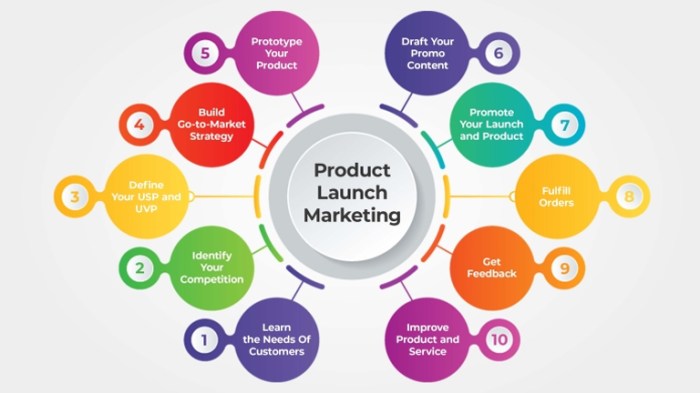Launching Product Campaigns sets the stage for this enthralling narrative, offering readers a glimpse into a story that is rich in detail with american high school hip style and brimming with originality from the outset.
When it comes to promoting products, creating captivating campaigns is key to grabbing the attention of consumers and driving sales. This guide will walk you through the essential steps in planning, creating content, and choosing the right marketing channels for successful product campaigns.
Importance of Launching Product Campaigns
Launching product campaigns is crucial for businesses as it helps in creating awareness about new products or services, generating excitement among customers, and ultimately driving sales. By strategically planning and executing product campaigns, businesses can reach their target audience, differentiate themselves from competitors, and build a strong brand presence in the market.
Examples of Successful Product Campaigns
- The launch of Apple’s iPhone series with innovative features and sleek design not only created a buzz in the tech industry but also set new standards for smartphones, resulting in record-breaking sales.
- Coca-Cola’s “Share a Coke” campaign, where personalized bottles with people’s names were introduced, led to increased customer engagement on social media platforms and boosted sales by creating a personal connection with consumers.
- Nike’s “Just Do It” campaign featuring famous athletes like Michael Jordan and Serena Williams not only promoted their products but also conveyed a powerful message of determination and excellence, resonating with their target audience and strengthening brand loyalty.
How Product Campaigns Help in Creating Brand Awareness and Customer Engagement
Product campaigns play a crucial role in creating brand awareness by showcasing the unique selling points of a product, communicating the brand’s values and identity, and reaching a wider audience through various marketing channels such as social media, television, and print ads. By engaging with customers through interactive campaigns, contests, and promotions, businesses can build relationships, gather feedback, and create a loyal customer base that drives repeat purchases and word-of-mouth referrals.
Planning a Product Campaign

When it comes to planning a product campaign, there are several key steps that need to be taken to ensure its success. From setting objectives and goals to identifying the target audience, each step plays a crucial role in the overall planning process.
Setting Campaign Objectives and Goals
To kick off a product campaign, it is essential to establish clear objectives and goals. This includes defining what you want to achieve through the campaign, whether it’s increasing brand awareness, driving sales, or launching a new product. By setting specific and measurable goals, you can track the success of your campaign and make adjustments as needed to ensure you are on the right path.
- Determine the main purpose of the campaign
- Set measurable goals that align with the overall objectives
- Establish key performance indicators (KPIs) to track progress
- Create a timeline for achieving each goal
Importance of Target Audience Identification, Launching Product Campaigns
Identifying the target audience is crucial in planning a product campaign as it helps tailor your messaging and strategies to resonate with the right people. By understanding who your target audience is, you can create content that speaks directly to their needs and interests, increasing the chances of a successful campaign.
- Conduct market research to identify key demographics and psychographics
- Create buyer personas to represent different segments of your target audience
- Use data analytics to track customer behavior and preferences
- Segment your audience based on common characteristics or behaviors
Creating Compelling Campaign Content
Developing engaging content for product campaigns is crucial to capturing the attention of your target audience and driving successful outcomes. Here are some tips for creating persuasive copy and visuals that will resonate with customers:
Crafting Persuasive Copy
- Highlight the unique selling points of your product in a clear and concise manner.
- Use compelling language that evokes emotions and connects with the audience on a personal level.
- Create a sense of urgency by incorporating time-limited offers or exclusive deals.
- Include customer testimonials or success stories to build credibility and trust.
Designing Captivating Visuals
- Ensure that your visuals are eye-catching and align with your brand’s aesthetic and messaging.
- Use high-quality images and videos to showcase your product in action and demonstrate its benefits.
- Incorporate engaging graphics or animations to add visual interest and enhance the overall appeal of your campaign.
- Optimize your visuals for different platforms and devices to reach a wider audience effectively.
The Power of Storytelling
Storytelling plays a crucial role in making campaign content more appealing to customers by creating an emotional connection and narrative that resonates with them. By weaving a compelling story around your product, you can engage customers on a deeper level and inspire them to take action. Whether it’s sharing the journey of how your product was created, highlighting real-life success stories, or painting a vision of the future with your product, storytelling can help differentiate your campaign and leave a lasting impression on your audience.
Choosing the Right Marketing Channels: Launching Product Campaigns

In the world of launching product campaigns, choosing the right marketing channels can make or break the success of your efforts. It’s crucial to select the most suitable channels that will effectively reach your target audience and drive engagement.
Comparing Different Marketing Channels
When it comes to marketing channels for product campaigns, there are several options to consider, including social media, email, and influencer marketing.
- Social Media: Platforms like Instagram, Facebook, and Twitter offer a wide reach and engagement opportunities through targeted advertising and organic content.
- Email: Email marketing allows for direct communication with potential customers, providing a personalized touch and the ability to track engagement metrics.
- Influencer Marketing: Collaborating with influencers can help leverage their audience and credibility to promote your product effectively.
Factors to Consider when Selecting Marketing Channels
When choosing the right marketing channels for your product campaign, it’s important to consider factors such as your target audience demographics, budget, campaign goals, and the nature of your product.
Understanding where your target audience spends their time online is crucial in determining the most effective marketing channels to use.
Examples of Successful Product Campaigns on Various Channels
– Social Media: The launch of Kylie Jenner’s cosmetics line on Instagram generated massive buzz and sales through influencer marketing.
– Email: The “Black Friday Deals” email campaign by Amazon is a classic example of effective email marketing that drives conversions.
– Influencer Marketing: The collaboration between Nike and professional athletes like Serena Williams showcases the power of influencer marketing in promoting sports gear.